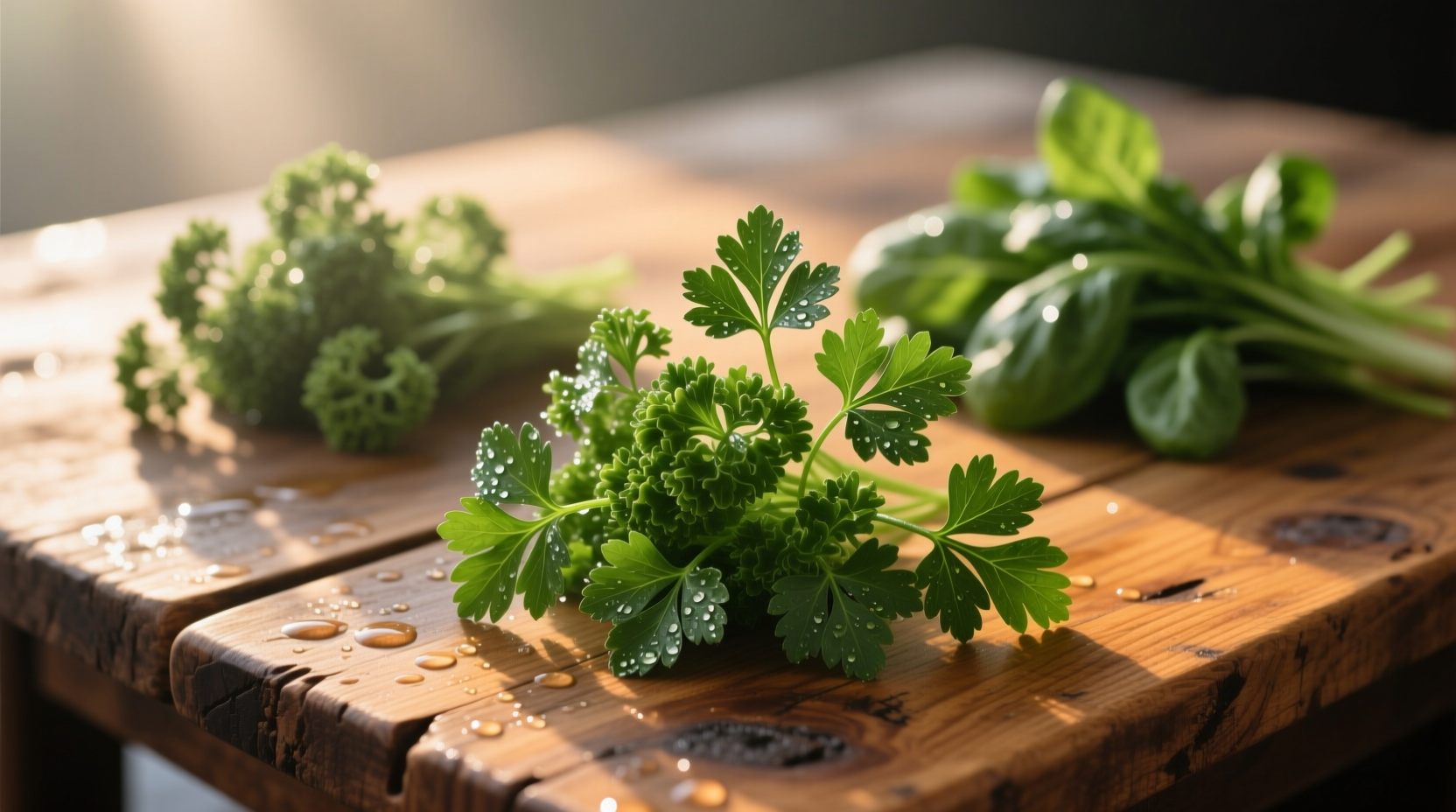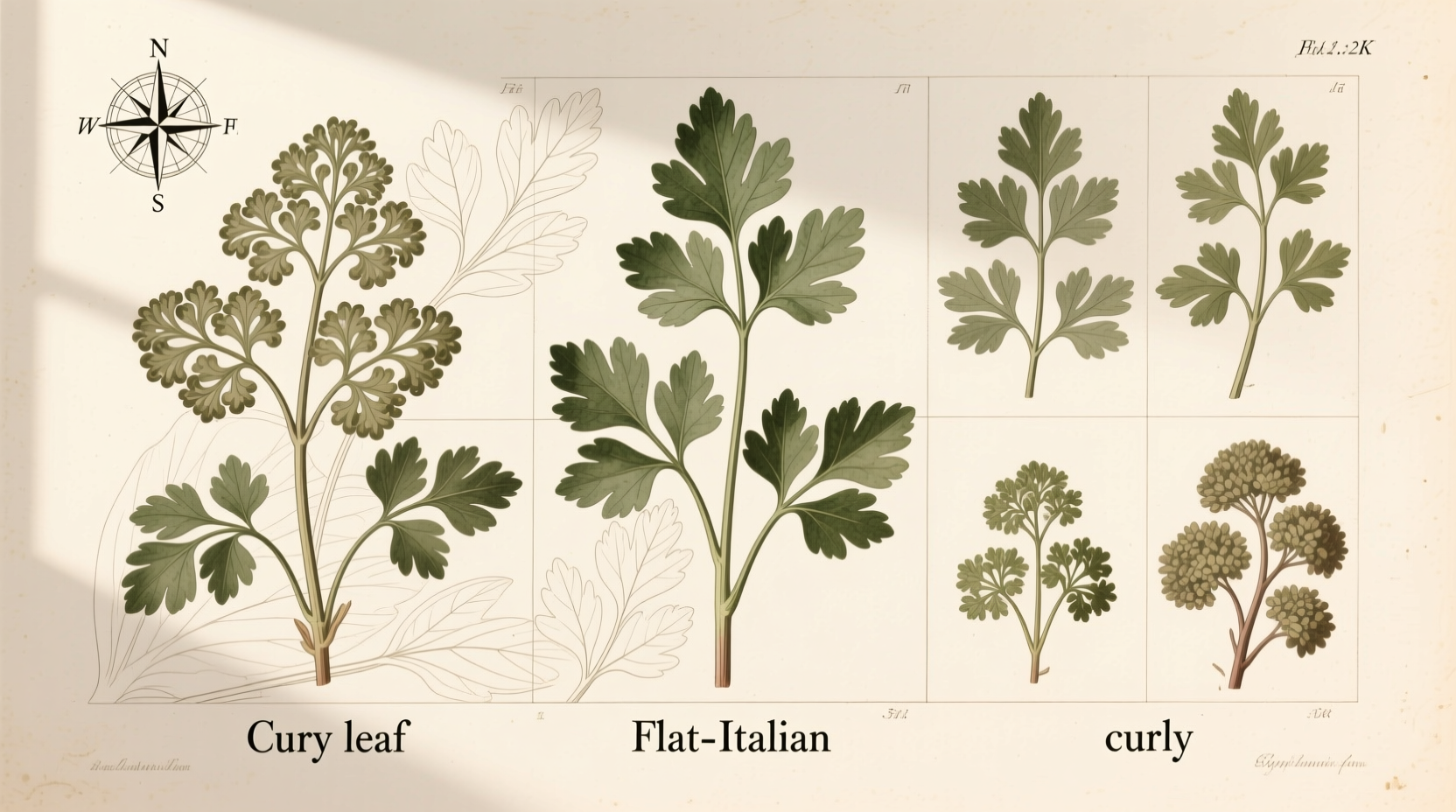Three primary parsley kinds exist: curly leaf (Petroselinum crispum crispum), flat-leaf/Italian (Petroselinum crispum neapolitanum), and Hamburg root parsley (Petroselinum crispum tuberosum). Curly parsley offers mild flavor ideal for garnishes, flat-leaf provides robust herbal notes preferred by chefs, and root parsley features edible tubers used in European cuisine. Each variety has distinct growing requirements, culinary applications, and nutritional profiles.
Understanding Parsley Varieties for Culinary Success
When selecting parsley for your kitchen or garden, knowing the specific characteristics of each variety makes all the difference. This comprehensive guide details the three main parsley kinds, their historical development, and practical applications that will transform how you use this essential herb.
The Three Main Parsley Varieties Compared
| Variety | Flavor Profile | Best Culinary Uses | Growing Season |
|---|---|---|---|
| Curly Leaf | Mild, slightly bitter | Garnishes, soups, stews | Spring-Fall (biennial) |
| Flat-Leaf (Italian) | Robust, earthy, pronounced herbal notes | Sauces, marinades, Mediterranean dishes | Spring-Fall (biennial) |
| Hamburg Root | Root: celery-like; Leaves: similar to flat-leaf | Roots in stews; leaves as herb substitute | Full season (biennial) |
Curly Leaf Parsley: The Classic Garnish
Curly leaf parsley (Petroselinum crispum crispum) features tightly curled, bright green leaves that provide visual appeal to finished dishes. While milder in flavor than its flat-leaf counterpart, this variety withstands cooking temperatures better, making it suitable for soups and stews where appearance matters. According to the USDA Agricultural Research Service, curly parsley contains 842% of the daily recommended vitamin K per 100g serving, along with significant vitamin C and iron content.
Gardeners appreciate curly parsley's resistance to bolting in warmer temperatures compared to flat-leaf varieties. When harvesting, cut stems from the outer portions first to encourage continued growth throughout the season.
Flat-Leaf Parsley: The Chef's Preferred Choice
Professional chefs overwhelmingly prefer flat-leaf or Italian parsley (Petroselinum crispum neapolitanum) for its superior flavor profile. With broader, darker green leaves, this variety delivers a more pronounced herbal taste with subtle peppery notes that enhance rather than overpower dishes. The University of California Cooperative Extension notes that flat-leaf parsley contains higher concentrations of apiol and myristicin—compounds responsible for its distinctive flavor—compared to curly varieties.
When substituting between parsley kinds, use a 1:1 ratio for flat-leaf to curly leaf, but reduce by 25% when replacing flat-leaf with the milder curly variety to maintain flavor balance. Flat-leaf parsley excels in pesto, gremolata, and Middle Eastern tabbouleh where its robust flavor shines.

Hamburg Root Parsley: The Dual-Purpose Variety
Hamburg root parsley (Petroselinum crispum tuberosum) represents the lesser-known third category, cultivated primarily for its edible taproot rather than its leaves. Popular in Central and Eastern European cuisine, this variety produces parsnip-like roots with a mild celery flavor that sweetens after frost exposure. The leaves resemble flat-leaf parsley but with slightly more serrated edges.
Gardeners growing Hamburg root should allow 90-110 days for root development. Unlike leaf varieties harvested throughout the season, roots are typically dug in late fall after foliage begins to yellow. The Cornell University Department of Horticulture recommends storing harvested roots in damp sand at 32-35°F for up to four months.
Historical Development of Parsley Varieties
Parsley's journey from Mediterranean native to global kitchen staple reveals how human selection shaped today's varieties:
- Ancient Greece (5th century BCE): Wild parsley (Petroselinum segetum) used medicinally and in funeral wreaths
- Roman Era: First cultivation records; used as both food and medicinal herb
- 1500s: Curly leaf varieties developed in Europe for ornamental and culinary use
- 1700s: Flat-leaf varieties selected for superior flavor in Mediterranean cooking
- 1800s: Hamburg root parsley standardized in Germany for root production
- Modern Era: Hybrid varieties developed for disease resistance and extended harvest
Practical Selection Guide: Choosing the Right Parsley Kind
Understanding context boundaries helps determine which parsley variety serves your specific needs:
When to Choose Curly Leaf Parsley
- Creating visually appealing garnishes
- Adding to long-simmered soups and stews
- Growing in warmer climates where flat-leaf might bolt
- When milder herbal flavor is preferred
When to Choose Flat-Leaf Parsley
- Preparing sauces, dressings, and marinades
- Making Middle Eastern or Mediterranean dishes
- When maximum flavor impact is desired
- Creating herb blends like fines herbes or gremolata
When to Choose Hamburg Root Parsley
- Adding to European-style root vegetable stews
- Seeking dual-purpose herb with edible roots
- Growing in cooler climates with longer growing seasons
- Exploring historical European recipes
Nutritional Comparison of Parsley Varieties
All parsley kinds deliver exceptional nutritional value, but subtle differences exist between varieties. According to USDA FoodData Central, a quarter-cup (10g) serving of fresh parsley provides:
- Vitamin K: 310% DV (all varieties)
- Vitamin C: 14% DV (flat-leaf slightly higher)
- Vitamin A: 11% DV (curly leaf slightly higher)
- Folate: 6% DV
- Iron: 4% DV
The primary nutritional difference lies in flavonoid content, with flat-leaf parsley containing approximately 15% more apiol—the compound responsible for its distinctive flavor and potential health benefits.
Growing Tips for Each Parsley Kind
Successful cultivation requires understanding each variety's specific needs:
Curly Leaf Cultivation
- Soil: Well-draining, pH 6.0-7.0
- Sun: Partial shade in hot climates
- Water: Consistent moisture (1-1.5 inches/week)
- Harvest: Outer stems first, leaving center to continue growing
Flat-Leaf Cultivation
- Soil: Rich in organic matter, pH 6.0-7.5
- Sun: Full sun (6+ hours daily)
- Water: Regular but avoid waterlogging
- Harvest: Cut stems just above leaf nodes to encourage bushier growth
Hamburg Root Cultivation
- Soil: Deep, loose, stone-free (for root development)
- Sun: Full sun
- Water: Consistent moisture, especially during root formation
- Harvest: Roots in late fall after first frost; leaves can be harvested throughout season
Preserving Parsley Varieties
Maximize your parsley harvest with these preservation techniques specific to each variety:
- Curly leaf: Best frozen in ice cube trays with water or oil for soups and stews
- Flat-leaf: Ideal for drying (retains more flavor than curly varieties) or making herb-infused oils
- Hamburg root: Roots store well in cool, humid conditions; leaves preserve like flat-leaf parsley
For immediate use, store fresh parsley stems in a glass of water (like flowers) with a loose plastic bag covering, changing water every two days. This method extends freshness for 1-2 weeks regardless of variety.
Frequently Asked Questions
Can I substitute curly parsley for flat-leaf parsley in recipes?
Yes, but with adjustments. Curly parsley has a milder flavor, so use 25% more when substituting for flat-leaf in cooked dishes. For raw applications like tabbouleh or chimichurri, flat-leaf is preferable due to its stronger flavor and easier chopping. The texture difference matters most in uncooked preparations where curly parsley's ruffled leaves can be difficult to incorporate evenly.
Why does my flat-leaf parsley keep bolting?
Flat-leaf parsley bolts (produces flowers prematurely) primarily due to heat stress or inconsistent watering. This variety is more sensitive to temperature fluctuations than curly parsley. To prevent bolting, plant early in spring or late summer, provide afternoon shade in hot climates, and maintain consistent soil moisture. Mulching around plants helps regulate soil temperature and moisture levels. Once bolting begins, cut flowering stems to extend leaf production.
How do I identify Hamburg root parsley from other varieties?
Hamburg root parsley can be identified by its distinctive taproot (resembling a small parsnip) and leaves that resemble flat-leaf parsley but with slightly more serrated edges. The plant grows taller (up to 24 inches) than leaf varieties. When grown for roots, the crown appears less dense than leaf varieties. The roots develop a characteristic pale beige color and should be harvested when 1-2 inches in diameter for optimal tenderness. Unlike leaf-only varieties, Hamburg root plants dedicate significant energy to root development.
Which parsley variety has the longest shelf life after harvest?
Flat-leaf parsley generally maintains freshness longer than curly varieties when stored properly. Its smoother leaves retain moisture better and are less prone to wilting. When stored upright in water with a loose plastic covering in the refrigerator, flat-leaf typically lasts 10-14 days compared to 7-10 days for curly leaf. Hamburg root parsley leaves behave similarly to flat-leaf, while the roots can be stored for several months in cool, humid conditions like other root vegetables.
Are there any parsley varieties suitable for container gardening?
Both curly and flat-leaf parsley thrive in containers with proper care. Choose compact varieties like 'Petris' (curly) or 'Giant of Italy' (flat-leaf) for best container results. Use pots at least 8 inches deep with drainage holes, and maintain consistent moisture without waterlogging. Container-grown parsley benefits from monthly feeding with balanced liquid fertilizer. Hamburg root requires deeper containers (12+ inches) to accommodate root development and is less suitable for small-space gardening unless specifically growing for roots.











 浙公网安备
33010002000092号
浙公网安备
33010002000092号 浙B2-20120091-4
浙B2-20120091-4